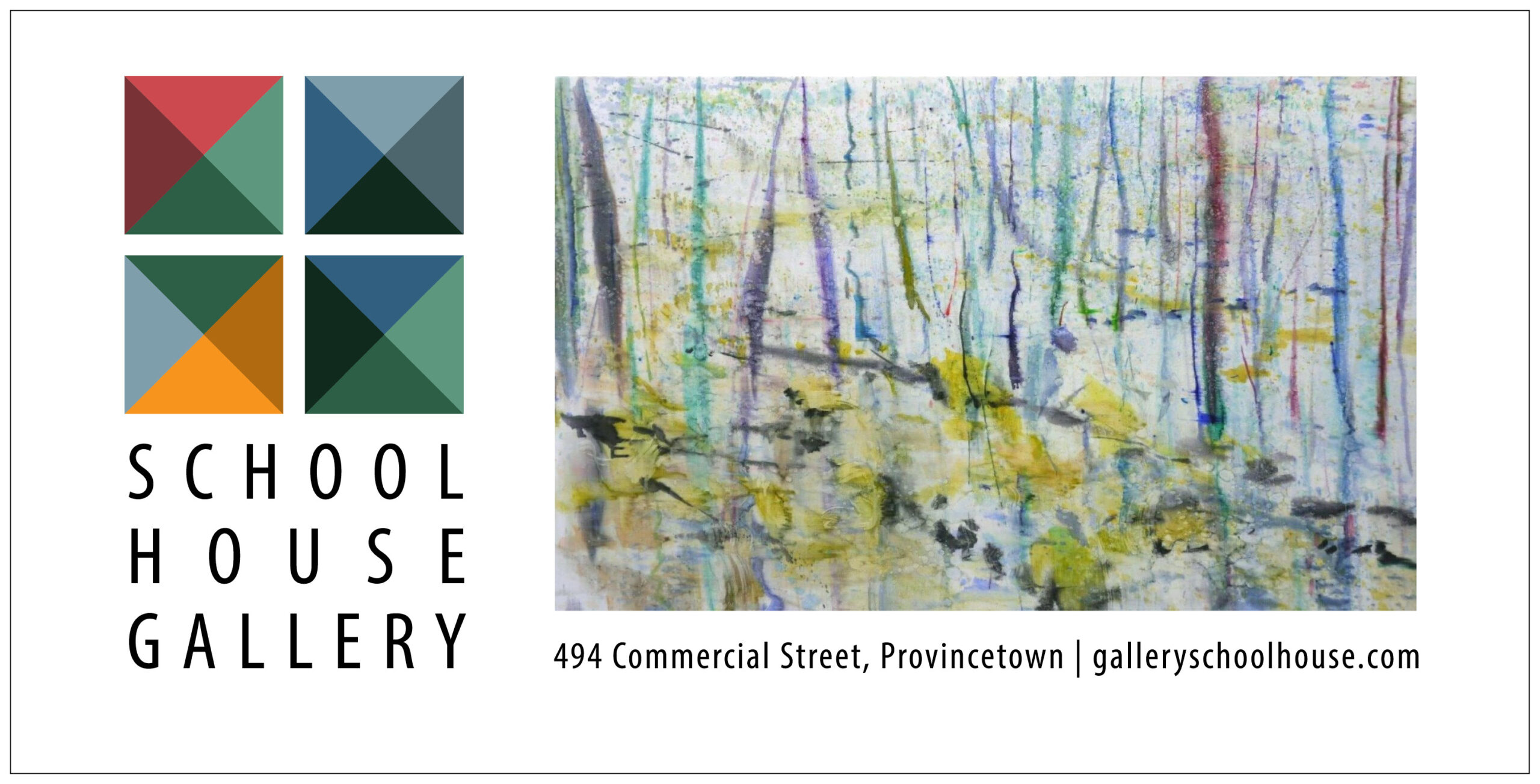The 1950s at Bakker Gallery
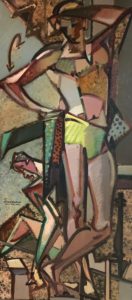
The 1950s, so often depicted as an era of cheery conservatism, were radical times in the world of painting.
A generation of painters was freed from subject matter external to painting, whether that be grand narratives or observed reality. The moment was perhaps best observed by the art critic Clement Greenberg. He argued that painting should be about painting itself — that is, about the material qualities of the medium: color, shape, surface, the grid.
A show at Bakker Gallery (359 Commercial St. in Provincetown) on display until July 4 captures the excitement of that heyday of modernism when painting was ripped open and anything seemed possible. Among the artists in that show, Haynes Ownby stands out as the most loyal to concepts of abstraction in a pair of black-and-white paintings in which he worked with the grid to organize his compositions, a strategy he likely inherited from his teacher Hans Hofmann.
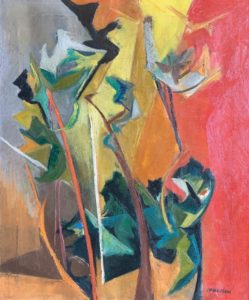
Hofmann, who taught many of these artists in Provincetown, provided a framework for artists to think about building an image without fealty to the observed world through an exploration of dissonance — a “push and pull” between elements. As a student of Hofmann in the ’50s, Myrna Harrison, an artist now in her 90s, created a dissonance between organic and geometric forms in a lush painting on display at Bakker.
The show also reflects the era’s fluid boundaries between abstraction and reality. In a large vertical painting, William Littlefield looks to reality for inspiration. He paints a muscular male model but freely cuts up the figure into an arrangement of geometric shapes, textured grounds, and juicy brush strokes. The painting echoes an abstract collage also on display.
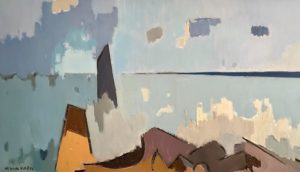
Herman Maril’s painting is a dreamy image, the picture seeming to fall apart. The shape of a sail cuts through the serene water, but there’s no boat. The clouds fall into the horizon. It’s not an unfinished or lazy painting but rather something that intentionally claims its own territory. Neither abstract nor realistic, it exists as a painting loyal to nothing but the vision of the artist.
—Abraham Storer
Emily Wilker at Room 68 in Wellfleet
There are a lot of landscape paintings around these parts. What distinguishes those of higher quality is the artist’s ability to harness landscape to convey something internal. Good landscapes are about vision, not just pretty pictures.
The landscape becomes a stage for Emily Wilker’s full range of humor and visual invention in her show Acts of Light, up until June 30 at Room 68 in Wellfleet (313 Main St.).
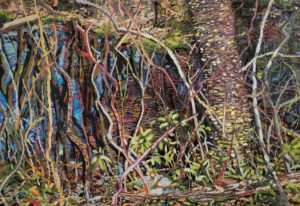
In a series of postcard-sized acrylic paintings, Wilker depicts the strange and wondrous world of the woods: frogs mating, caterpillars crawling through flowers, fungi swelling from logs, and strawberries ripening. She focuses our attention on a world that is bursting with color and detail. There’s something funny about this vision: here nature is flamboyant, eccentric, and even erotic.
In Wilker’s larger paintings, she depicts the woods with an insatiable curiosity about what paint can do. In her artist statement, she writes, “Surfaces are scratched, carved, layered, and peeled back again.” She touches areas with detailed marks, glues on rocks, builds up forms with clay, and pours paint in these freewheeling pictures. The wild world of the woods is a good match for her ecstatic painting moves.
Edel Bordon and Aissa Santiso’s Post Modernidad
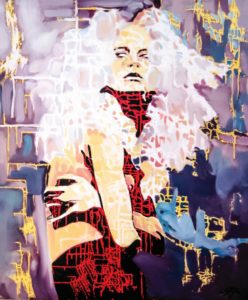
Edel Bordon and Aissa Santiso are two Cuban artists of different generations linked by the San Alejandor School of Art in Havana. Bordon served as Santiso’s teacher and is the father of her romantic partner, according to Galería Cubana director Michelle Wojcik.
In addition to sharing loved ones and an institutional connection, the artists also share a love of surface and decoration in their figurative paintings.
In an exhibition titled Post Modernidad (“Post Modernity”) and on display until July 4 at Galería Cubana (357 Commercial St. in Provincetown), viewers can see Santiso’s portraits of women.
“She’s playing with gender in a lot of the pieces,” says Wojcik. The women in her paintings are aware of an audience, posing self-consciously. Their sharp features and clothing reference fashion advertisements. Santiso covers surfaces of the painting with drips of paint, contrasting the controlled drawing of the figures and creating a hazy, hallucinatory atmosphere.

Bordon’s figures also exist in a busy visual reality. In a long horizontal painting, a figure rows a canoe — but it’s not a peaceful outing on a lake. A cacophony of marks creates a tense, vibrating energy. The figure is covered in looping swirls and the sky is filled with branching lines. The figure is working hard in this painting, back hunched and rowing forward, but the viewer sees no destination in sight amid the noise and effort.
A Book, a Movie, and, Obviously, a Dog
At a coffeeshop in Palm Springs one morning in 2005, a dog — a golden retriever — was barking at James Egan. Wagging his tail, the dog begged at Egan’s table. The dog’s owner, a handsome man, came over to retrieve the retriever. He introduced himself as Dan Perdios.
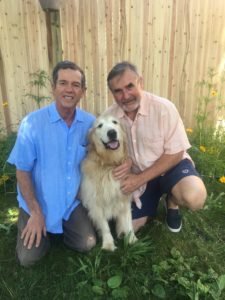
Egan and Perdios went on date and hit it off immediately. But Egan, a film producer, was about to head across country to Cape Cod to help shoot Wild About Harry, a film about a teenager who discovers her father has a boyfriend. It looked like the beginning of their relationship would also be the end.
“But then I said, ‘Maybe I could come,’ ” Perdios recalls. “I told James, ‘It’s going to be lonely for me to wait for you, but maybe you can get me a job on set, and I’ll feel included.’ ” Perdios hopped on the plane to Boston with Egan with a new job title: assistant prop gofer.
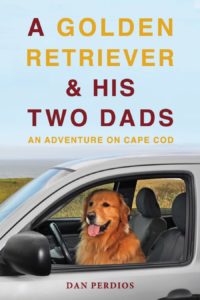
Egan and Perdios have been together for 17 years now. They live in Buzzards Bay. The tale of their canine-facilitated meeting, their time on the set of Wild About Harry, and the relationship that has followed is recounted in Perdios’s book, A Golden Retriever and His Two Dads. A signing will take place in the Provincetown Public Library (356 Commercial St.) on Thurs., June 23, immediately following a screening of Wild About Harry, beginning at 5:30 p.m.
Speaking of Wild About Harry, Egan says, “It’s a wonderful chance to see a story about a gay family from the point of view of the kids.” The film was written by Gwen Wynne, a Cape Cod native who based the story on her own father. “Gwen was really challenged by her father coming out, and she wrote this script about how she tried to make him straight initially,” Egan says.
“It’s a good book to read at the beach,” says Perdios. It begins with his relationship with his dog, Willy, who was there for him when he was diagnosed with AIDS and, later, when he lost part of his hearing as a result of the disease.
AIDS Activist Peter Staley Was Never Silent
One sleepy night in 1985, Peter Staley, a 24-year-old bond trader on Wall Street, and his boyfriend sat on the couch and watched the made-for-television movie An Early Frost, about a lawyer who learns he has AIDS. Sitting in front of the TV, Staley couldn’t help but observe similarities between the symptoms depicted in the film and some of the medical problems he’d been having. He went to the doctor — the test came back positive.
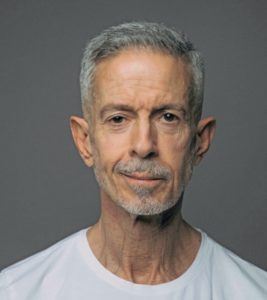
Staley joined the AIDS Coalition to Unleash Power in New York City in 1987 shortly after its founding. In 1988, he quit Wall Street and became a full-time AIDS activist, joining ACT UP’s all-important Treatment & Data Committee, which later broke off and became its own group, the Treatment Action Group. Staley would go on in 1994 to join President Clinton’s National Task Force on AIDS Drug Development, helping to make AIDS treatments more available today than anyone could have imagined.
At ACT UP, Staley organized some of the group’s most spectacular, theatrical actions, like shutting down the trading floor of the New York Stock Exchange and putting a larger-than-life condom over the house of North Carolina Sen. Jesse Helms.
All this and more is recounted in Staley’s memoir Never Silent: ACT UP and My Life in Activism. Staley will be at East End Books in Provincetown (389 Commercial St.) to discuss the book on Friday, June 24 at 6 p.m. The event, which will also be live-streamed via Zoom, is free but pre-registration is required. For more information and to register, visit eastendbooksptown.com.
